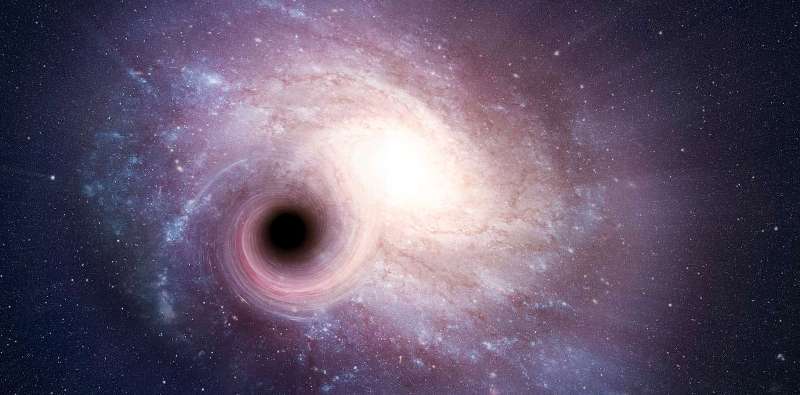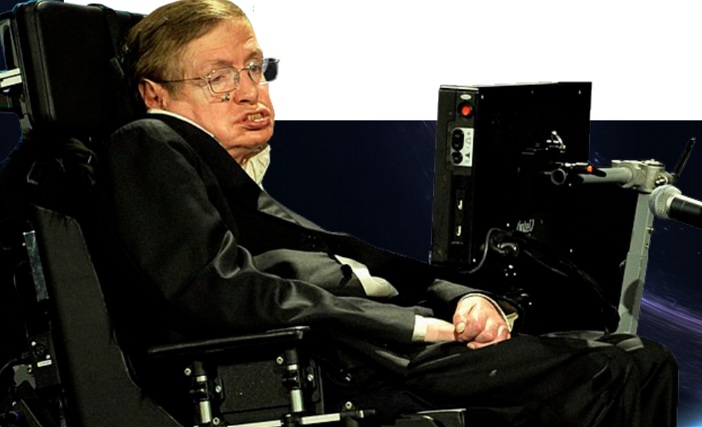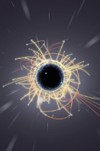
Think about the following questions.
1. Can you name any famous physicists? What do you know about their contributions to science?
2. What do you know about Stephen Hawking?
3. What are black holes?
VOCABULARY PREVIEW
Match each New Academic Word List(NAWL) word with the correct definition.
- theorist _____
- comparable _____
- calculation _____
- articulate _____
- atom _____
- particle _____
- a. the act of finding a number through a mathematical process
- b. to express in words
- c. the smallest unit of a chemical element
- d. a person who forms theories
- e. similar and suitable for comparison
- f. in physics, a very small part of matter
HAWKING RADIATION

Stephen Hawking was probably the best-known physicist of the late 20th century. The reasons for this include the brilliant accomplishments in his field, as well as the fact that he continued his work as a theorist despite suffering from a disability that left him with extremely limited speech and mobility1. Hawking's work focused on black holes, his most famous theory stating that black holes must radiate2 energy and eventually disappear. This was such an original and unexpected idea that the phenomenon3 it describes has come to be known as “Hawking radiation.”
Hawking was born in 1942 in Oxford, England. As a child, he showed great ability in mathematics and physics. He graduated from Oxford University in 1962 and earned his PhD in cosmology4 from Cambridge University in 1966. During this time, Hawking was diagnosed with Amyotrophic Lateral Sclerosis (ALS), a rare degenerative disease that gradually destroys a person's ability to move and speak. Rather than discouraging him, the news inspired Hawking to work even harder and make his mark on science while he still could.
In 1974, Hawking proposed his fascinating theory that black holes are not totally "“black," that they are not simply one-way "drains" of the universe that do nothing but consume everything around them. (A black hole is not literally a hole but rather an object in space with such a strong gravitational pull that nothing nearby can escape from it.) According to Hawking's theory, a black hole also radiates energy, and gradually, it loses mass. The smaller the black hole becomes, the faster it loses mass, and eventually, it disappears completely. This can only happen when it has nothing to consume.
Hawking's theory has been very influential, though it is difficult to understand even for his colleagues. Hawking explained his theory with mathematical calculations, but it is much harder to articulate in everyday language. One way to try to understand it is by imagining pairs of opposite particles: one matter, the other antimatter. Normally, matter and antimatter particles annihilate each other and simply disappear. But this can change at the event horizon-the point of no return at which matter and energy are sucked by gravity into the black hole. It is possible for a particle of antimatter to be separated and sucked in before canceling out its matter counterpart. The antimatter particle then develops negative energy. This negative energy is added to the black hole, and because of this, the black hole must lose some mass, which it does in the form of photons (light particles) and various kinds of other particles. Theoretically, these particles, called Hawking radiation, can be seen and measured. So if we can ascertain5 that particles are escaping from a black hole, we can deduce that the hole is losing mass at the same time.
According to the theory, Hawking radiation can only occur if a black hole is not actively consuming anything. Since all known black holes are surrounded by clouds of gas which they are pulling in, for many years, it was impossible to prove Hawking's theory. But in 2014, physicist Jeff Steinhauer of the Israel Institute of Technology observed Hawking radiation for the first time-being emitted from a model black hole in a laboratory. The physics community remains cautious about concluding that the model, produced with hyper-cooled rubidium atoms, reproduces conditions comparable to a real black hole. And the results still need to be replicated6. But the consensus is that if the findings stand, the radiation observed is, in fact, exactly what Hawking predicted.
Hawking's work on black holes made him a scientific celebrity, and in 1979, he attained7 the post of Lucasian Professor of Mathematics at Cambridge, the position held by Sir Isaac Newton 300 years earlier. Although ALS left him restricted to a wheelchair, and he required a voice synthesizer to communicate, Hawking remained active in physics and continued to publish his research in scientific journals; in fact, he published his last paper in 2018, the year of his death. He also continued to give public lectures in many countries and appear on television. He has been very influential in presenting modern theories of the universe to ordinary people, particularly in the books A Brief History of Time (1988) and The Universe in a Nutshell (2001). Hawking's genius, his love of his work, and his persistence8 despite an extremely difficult illness are both inspiring and humbling9.
New Academic Word List
- mobility 1 : n. the ability to move
- radiate 2 : v. to send out; to emit
- phenomenon3 : n. an event; occurrence
- cosmology4 : n. a branch of science concerned with the origins, processes, and structures of the universe
- ascertain 5 : v. to find out for certain
- replicate 6 : v. to repeat or reproduce
- attain 7 : v. to succeed in getting or doing
- persistence 8 : n. a state or a quality of not quitting or giving up; continuing in spite of struggles
- humbling9 : adj. causing a feeling of modesty or deference
READING COMPREHENSION
A ‣ Mark each statement as true (T) or false (F) according to the reading.
- Hawking's talent for math and science was apparent from an early age.
- True
- False
- According to Hawking's theory, the larger a black hole becomes, the faster it loses mass.
- True
- False
- Explaining Hawking's theory using math is much easier than explaining in words.
- True
- False
- Hawking radiation has not yet been detected in space because there are no known black holes with suitable conditions.
- True
- False
- Hawking's illness forced him to retire from scientific research.
- True
- False
B ‣ Choose the best answer according to the reading.
- What is the reading mainly about?
- a. Hawking's personal obstacles and how he overcame them
- b. How Hawking's theories have been proven correct
- c. Hawking's life and his major scientific contributions
- d. How Hawking has replaced Newton as the premier voice in physics
- Before Hawking, physicists believed that black holes _____.
- a. only gave off energy but did not consume any
- b. only consumed energy but did not give off any
- c. only lost mass but never gained any
- d. never lost or gained any mass
- The word annihilate in paragraph 4 is closest in meaning to _____.
- a. attract
- b. destroy
- c. strike
- d. defeat
- What can be inferred from paragraph 5?
- a. Most scientists remain doubtful that Hawking radiation exists.
- b. There will be more attempts to observe Hawking radiation in a lab.
- c. Hawking was surprised by the results of Steinhauer's research.
- d. Hawking disagrees with the use of model black holes for research.
C ‣ Fill in the blanks with information from the passage.
- During his time at university, Hawking was _____ the disease ALS.
- Blacks holes have an immense _____ pull that surrounding objects cannot escape from.
- Under normal conditions, matter and antimatter particles _____ each other and disappear.
SUMMARY
Write the number of each sentence under the category it belongs to.
| The Life and Contributions of Stephen Hawking | |
| Before 1979 1 _____ |
1979 and Later 2 _____ |
- He proposed his theory of Hawking radiation, which argues that black holes radiate energy as well as consume it.
- He authored two popular books, and one of his theories appeared to have been confirmed.
- He showed a great interest in mathematics and physics.
- He was diagnosed with a rare illness that affects the nerves.
- He was given the same post at Cambridge once occupied by Sir Isaac Newton.
- He continued giving public lectures and making TV appearances in many countries in spite of his disabilities.
VOCABULARY PRACTICE
Fill in the blanks with the words in the box. Change the form if necessary.
- theorist
- particle
- calculation
- articulate
- atom
- comparable
- NASA employs many _____ in addition to those who handle practical research and engineering tasks.
- The energy in a nuclear explosion comes from splitting _____ of enriched uranium or plutonium.
- According to most scientists' _____ , our Sun will probably die out in roughly four billion years.
- A good teacher must not only understand complex ideas but also be able to _____ them clearly.
- In 1897, J. J. Thomson discovered the electron, the first known _____ smaller than an atom.
- The cars are _____ in price, but far apart in terms of performance.
SUPPLEMENTAL READING
Virtual Particles

Stephen Hawking’s theory about black hole radiation is based on quantum theory. One of the basic elements of quantum theory is the idea of virtual particles. In Hawking’s black hole theory, radiation from black holes comes from the actions or qualities of virtual particles. But what are virtual particles?
Basically, virtual particles are subatomic (smaller than an atom) particles that are both released and taken in by other particles. Virtual particles appear and disappear extremely quickly. They affect the interaction of real particles in various fundamental ways. For example, the exchange of virtual particles between electrons can be said to carry an electromagnetic force. Pairs of opposite virtual particles—particles of matter and particles of antimatter—arise and disappear at all times, everywhere.
The most important fact to remember about virtual particles is that they are not independent objects. They are used when making predictions about subatomic processes. These predictions cannot be accurate unless virtual particles are included in the equations. They are necessary for the equations to work, even though they cannot be observed as part of the process.
Virtual particles appear and disappear so quickly that they cannot be directly measured with any current technology. This is not only because of the limitations of our technology but also because virtual particles are in existence too briefly to matter to the known natural laws of the universe.
In this sense, they are “unreal,” even though real phenomena that could not occur without their existence can be observed. Whether they are actual parts of physical processes or ways to make calculations work is not so important. The calculations are correct, and the predictions work, even though virtual particles themselves remain outside our scrutiny.
Fill in the blanks with information from the reading.
- Virtual particles are a basic part of _____ , on which Hawking's ideas about black hole radiation are based.
- One reason virtual particles cannot be observed is that they _____ too quickly.
- The other reason is that current _____ is not advanced enough.

Leave a comment
Load more